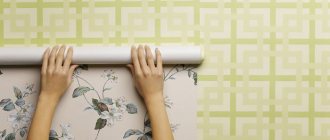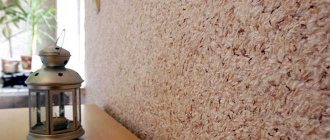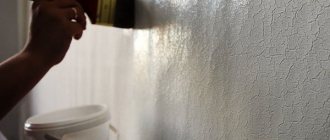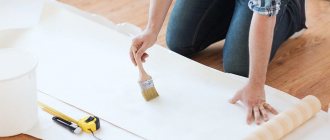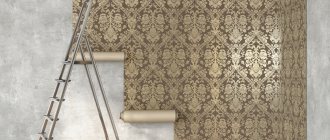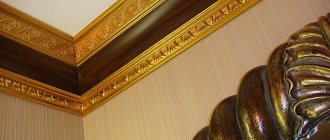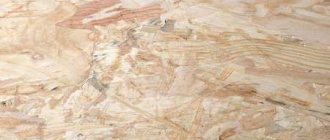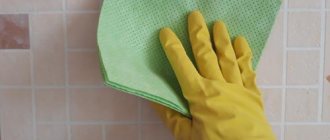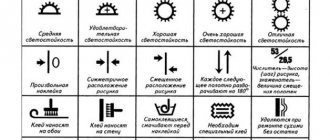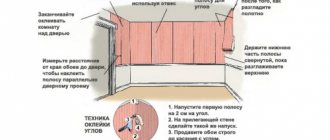The need to change your home interior or add newness and comfort to it can arise completely unexpectedly. If this process requires pasting the walls, and there is snow outside the window, the person who is determined to renovate begins to doubt and wonder whether it is possible to glue wallpaper in the apartment in winter? Or is it better to wait until summer?
Most often, a person finds himself at the mercy of stereotypes that claim that wallpapering in winter is a difficult and thankless task. However, reviews from specialists professionally involved in renovations indicate that the time of year is not at all an obstacle to beauty and comfort. And when asked whether it is possible to glue wallpaper in winter, they confidently answer positively.
Basic rules for wallpapering
Pasting in the house is carried out at any time of the year. The main thing is to follow the basic rules.
When deciding to change the wall covering, it is important to know about all the features of this material. In order for the wallpaper to adhere securely, the following conditions must be met simultaneously:
- Maintain temperature conditions in the range of 15-20°C. At low temperatures, the glue takes a long time to dry and the likelihood of peeling increases. High temperatures cause the composition to dry out too quickly, and the coating does not have time to harden.
- Use an adhesive that is compatible with the type of wallpaper. Wall covering manufacturers typically produce adhesives. It would be a smart decision to choose wallpaper and glue from the same brand.
- Before pasting the walls, they are treated with a primer. To do this, use special solutions or dilute wallpaper glue to a liquid consistency. Fresh and porous walls are treated several times, as they quickly absorb liquid.
- Complete absence of drafts. During the entire drying time of the glue (1-2 days), it is forbidden to open windows and artificially ventilate the room. It is also prohibited to speed up the drying of the adhesive.
- Sudden changes in temperature should be avoided. Pasting of the room is carried out after establishing a constant temperature or the beginning of the heating season.
- The walls of the house must be dry. To check the humidity, the day before the start of repair work, a piece of polyethylene is glued to the surface of the wall with mounting tape. If moisture accumulates on the polyethylene after 24 hours, then the surface is not suitable for gluing. Additional devices should be used to dry the room.
This set of rules is considered universal and is suitable for any time of year. Their implementation will be decisive when choosing when it is better and when it is impossible to glue wallpaper - in winter, spring, summer, autumn.
The optimal time from a climatic point of view is considered to be mid-spring or autumn, when the thermometer is in the desired range. However, other periods are also suitable for carrying out repair work. There is no prohibited time for wallpapering; there are unsuitable microclimatic conditions.
Is it possible to glue wallpaper in an apartment in winter - advice from experts
Pros and cons of winter gluing
It is no secret that each process has certain advantages and disadvantages, and in our case there are no exceptions either.
To understand whether it is possible to glue wallpaper in winter, we suggest studying all the positive and negative aspects. Let's start with the advantages:
- One of the advantages of this factor is that there are no significant daily temperature fluctuations and drafts in the room, because the windows are tightly closed and the heating system is working. Thanks to this, the likelihood of obtaining a high-quality result from gluing walls increases;
- Some problems are created by an increased level of air humidity, but working heating eliminates this disadvantage to some extent.
Unfortunately, as a drawback, there is unevenness in the drying of the walls - along the radiators, the wallpaper dries faster and better, and the main surfaces reach the desired state later.
Craftsmen advise using PVA glue for gluing - it is less susceptible to differences in temperatures.
Overview of various surfaces
What can you encounter when starting a renovation? What kind of walls can there be?
Dye
Paint layer as a basis for wallpaper
Is it possible to glue wallpaper on painted walls?
To better answer this question, let's take a look at the properties of paintwork:
- It is even, as this is one of the requirements for applying the suspension. That is, all work on leveling the surface has already been done.
- And also overly smooth. The layer formed from the paint has a very low level of adhesion with wallpaper glue; there is simply nothing for the solution to cling to.
Thus, you only need to “spoil” the smoothness of the coating so that the adhesive liquid can efficiently fulfill its purpose. To do this, you first need to determine the type of suspension applied to the wall.
It's easy to do it yourself:
- We take a sharp metal spatula and try to remove the colored deposit in a small area.
Light flaking is a sign of oil paint.
- If the coating comes off relatively easily and in layers, this means that oil paint was used to create it. If it is bad and only in small parts, then this indicates the use of acrylic emulsion.
Which canvases are better to choose?
To better understand whether it is possible to glue wallpaper in a heated room in winter, we suggest considering the existing options and studying the main pros and cons. According to general indicators and performance characteristics, wallpaper material is divided into the following varieties:
- paper - a classic inexpensive option, consisting of one or two layers. It is environmentally friendly, allows water and air flow to pass through, wears out quickly, absorbs various odors and is not subject to wet cleaning;
- non-woven - the structural structure of such a fabric is a paper base on which a material containing fabric fibers is applied. Used for finishing wall surfaces and ceilings, perfectly masks uneven areas, provides vapor permeability, resists wear, is durable and environmentally friendly;
- vinyl - a layer of foamed vinyl is applied to paper or non-woven fabric, providing the wallpaper material with a variety of textures. Wallpaper can be smooth, corrugated, or with a relief pattern. The material has a long service life, practically does not change the original shade when exposed to ultraviolet radiation, masks minor wall defects, and is not susceptible to the negative effects of a humid environment. The positive aspects are the possibility of tenfold dyeing and wet cleaning. Unfortunately, the vapor permeability of the canvas leaves much to be desired;
- acrylic - represented by a layer of foamed acrylic applied to a paper base. Performance characteristics are as similar as possible to vinyl ones. Wallpaper, unlike this analogue, is capable of permeating air, but its service life is somewhat shorter;
- natural - an expensive wallpaper material, the manufacture of which uses bamboo, wood veneer, cork bark, algae and even straw. As a rule, paper is used as a base. It is 100% environmentally friendly, but is susceptible to water and changes color under sunlight;
- glass wallpaper - when creating such canvases, fiberglass is used, which is durable and environmentally friendly. The material is used for a long time and is repainted at least one and a half dozen times. It hides uneven areas of walls under its layer, is non-flammable, and prevents the appearance of mold. The main drawback is the limited number of textures.
- textile - a fabric layer of velor, cotton, linen or silk fibers is applied to a paper or non-woven base. It looks beautiful on the wall, is expensive, protects against extraneous noise and helps conserve thermal energy inside the room. Absorbs odors, gets dirty, gets wet;
- metal – the outer layer is made of thin foil material, characterized by increased wear resistance, resistance to sunlight, and excellent sound insulation. Easily washed off from dirt;
- liquid - a complex structure that combines the quality characteristics of wallpaper material and decorative plaster mortar. The main raw material for preparation is cellulose fibers. It is sold in the form of a dry powder mixture, which is mixed with water immediately before application to the wall. The canvases do not leave joint areas, look beautiful and decorative, perfectly level the wall surface, are environmentally safe and have antiseptic properties. This coating can be used for six to ten years;
- photo wallpaper – base – paper with a self-adhesive surface. The material has a long service life, does not get wet and does not allow air flow to pass through.
Preparing the walls
In order for the wallpaper to lie flat, you need to prepare the walls before gluing. The complexity of the process depends on the type of surface:
1. Plasterboard walls. Apply primer at least 24 hours before wallpapering. This is necessary to protect the surface and, if desired, remove the wallpaper without any problems.
2. Painted walls. Wash the walls with a special solution, rinse with water, and sand for better adhesion of the glue.
3. Walls with wallpaper. There are several ways to remove old finishing material from the surface (with a scraper or a special solution). The solution is diluted in warm water, applied to the walls for at least 10 minutes, then the wallpaper is removed from top to bottom with a spatula. A steam cleaner will also make the process of removing old wallpaper easier.
4. Damp walls. Treat, turn with primer and wait for the time indicated on the package. If cracks and holes appear on the wall, fill them with putty. After drying, wipe the wall from dust and make sure it is smooth and clean.
Pasting process
If you decide to glue wallpaper in your apartment in winter, follow all the tips and the sequence of work steps.
Preparatory activities
Having learned that wallpapering is possible in winter, you can easily organize wall repairs before the New Year holidays. First of all, you will have to dismantle the old wallpaper. To facilitate the process of cleaning them, the surface of the decorative material is moistened with warm water, after which it is cleaned with a sharp spatula.
Try to remove old canvas completely, without leaving even small pieces.
Wet wallpaper will increase the level of air humidity, so you will have to wait a while for the room to dry out.
Having removed the old covering layer, the wall surface is inspected for damaged areas. All identified chips, cracks and other defects are repaired using a finishing putty mixture and reinforcing mesh. As soon as the leveling solution has dried, the protruding irregularities are smoothed over with sandpaper.
Padding
It is recommended to use a primer composition containing antiseptic additives. The mixture penetrates deeply into the surface of the wall, holds its small particles together, creates a protective film against the formation of mold, and enhances the adhesion index. The primer is applied in two layers, allowing the time necessary for each of them to dry completely.
If you doubt whether it is possible to glue wallpaper in a cold room, then you are doing the right thing - repair work will not give a positive result.
Pasting wallpaper material
We continue to figure out what time of year is best to hang wallpaper in an apartment and move on to the essence of the main action.
When the surface is completely prepared for work, we begin gluing the canvases. We adjust the design, if necessary, and cut strips of the required length, allowing for a certain margin for trimming.
The sequence of actions is as follows:
- prepare glue, spread it on the canvas or just the wall (depending on the type of wallpaper);
- glue the strip on, press it with a roller or rag, squeezing the air out from under it;
- As soon as the surface is dry, trim off the excess areas along the edges.
Use of substrates
Another interesting method for finishing concrete walls for wallpapering is using backing on the wall. This method is used when non-woven wallpaper needs to be glued. This backing is made from cork or polyurethane. They can be called a universal tool, since thanks to them you can easily hang wallpaper and also provide good sound and heat insulation. This way you can kill two birds with one stone. Footboards are especially relevant in the decoration of external walls, which are always cold.
Advantages and disadvantages of winter gluing
Freshly hung wallpaper is afraid of two things - drafts and sudden changes in temperature. In winter, both causes rarely appear.
Trying to get rid of heat leaks, apartment owners block even the slightest sources of draft. In winter, the temperature is characterized by its high stability, and in a heated room it does not play a decisive role. Active heating also helps eliminate excess moisture and dry out the walls.
The main disadvantage of winter repairs is functioning heating. Hot radiators instantly dry out the air and nearby walls. Taping these walls becomes a big problem. To solve this, use PVA glue, which is generously applied to problem areas.
If it was not possible to cover the battery section, the work will be postponed to a later date, after the end of the heating season.
The main differences between winter and summer wallpapering in a warm room are the level of humidity. In winter, this figure is low, since radiators dry the air well. As a result, the glue may dry out before setting.
In summer the situation is completely opposite. High humidity levels have a negative impact on repair work, walls take a long time to dry, the risk of wallpaper coming off increases, and bubbles appear.
Note! The optimal humidity level is considered to be 60%.
Is it possible to glue wallpaper in an apartment in winter - advice from experts
Pros and cons of winter gluing
It is no secret that each process has certain advantages and disadvantages, and in our case there are no exceptions either. To understand whether it is possible to glue wallpaper in winter, we suggest studying all the positive and negative aspects.
Let's start with the advantages:
- One of the advantages of this factor is that there are no significant daily temperature fluctuations and drafts in the room, because the windows are tightly closed and the heating system is working. Thanks to this, the likelihood of obtaining a high-quality result from gluing walls increases;
- Some problems are created by an increased level of air humidity, but working heating eliminates this disadvantage to some extent.
Unfortunately, as a drawback, there is unevenness in the drying of the walls - along the radiators, the wallpaper dries faster and better, and the main surfaces reach the desired state later.
Craftsmen advise using PVA glue for gluing - it is less susceptible to differences in temperatures.
Difficulties in gluing wallpaper in winter
The modern market offers hundreds of types of finishing materials with different properties. Anyone thinking about decorating the inside of a house in winter should remember one universal rule. Having chosen a finishing material, we first study the manufacturer’s recommendations/instructions for working with it. For example, the optimal humidity and temperature of the room and base when gluing wallpaper. How long should this temperature be maintained? Foundation requirements. Temperature requirements for glue or plaster mortar, etc. Now ask yourself the question, can you meet all these conditions if the finishing work is carried out in winter ?
Go ahead. Wallpaper is a private guest in country houses, especially when it comes to beautiful photo wallpapers that organically fit into the design of the room. To the question whether it is possible to glue wallpaper to walls in winter so that it does not fall off later, the answer is affirmative, but only if the following general conditions are met:
- The surface of the walls must be prepared for gluing wallpaper - leveled and primed.
- The room is stable, without sudden changes, and maintains a positive temperature of approximately + 15 °C.
- The temperature of the base (walls) is not less than + 5 °C.
- There are no drafts in the room and optimal humidity is maintained.
- The glued wallpaper should dry evenly.
Gluing wallpaper to walls in winter is actually no different from summer. The main thing is to maintain optimal conditions necessary for working with the material. And this is the most important problem if the outside temperatures are consistently below zero.
To hang wallpaper in winter, you will first have to start the heating system of the house. Heat the room where the work is taking place and maintain this temperature during the finishing process. Traditionally problem areas are behind radiators. If the batteries are already hanging, then it is difficult to bypass the mounting brackets and properly glue the wallpaper on a locally overheated wall, because The glue dries quickly before it has time to adhere to the base.
Difficulties of winter wallpapering
It is believed that low temperatures outside the window negatively affect the quality of repairs, since there is a working temperature range for wallpaper glue. For this reason, homeowners in an apartment building are concerned about whether it is possible to glue wallpaper to a cold wall in winter.
Experts say that gluing can be done if there is no frost or frost on the walls. That is, if the temperature of the walls is above zero. This requirement is easily met with functioning heating. Otherwise, the primer and glue will freeze without beginning to perform their functions.
Note! Wallpaper on a cold wall is glued according to the usual pattern. The only difference is the drying speed of the composition. In such conditions it takes a little longer to dry. This factor must be taken into account when carrying out repair work.
If there are no problems with gluing in warm houses, is it possible to glue wallpaper in an unheated room in winter? When answering the question, it is important to take into account the following microclimatic factors:
- Temperature . If in the room where the renovation is being carried out, the thermometer drops below 10-15°C, then gluing is not carried out. The adhesive will not be able to perform its tasks, and the wallpaper will soon fall off.
- Humidity . Unheated rooms are characterized by wet walls. A small difference between room and street temperatures does not allow the surface to dry sufficiently. The glue will not be able to fully saturate the walls and hold the wallpaper. The problem is solved by increasing the ventilation of the space without the appearance of drafts.
To cover unheated rooms, it is necessary to use special antifungal impregnations and vapor-permeable wallpaper. Otherwise, there is a high probability of fungus appearing and growing on the walls.
How to hang wallpaper in winter?
If you decide to wallpaper your room in winter, then follow the recommendations of experts and proceed step by step.
Preparing the base
First you need to remove the old wallpaper from the walls. If they come off difficult, you will have to moisten them a little. To do this, use a spray bottle or just a wet rag.
Pry up the wet wallpaper with a spatula and carefully remove it. Try to remove all pieces of wall coverings from the wall. Please note that wet wallpaper increases the humidity level in the room. Therefore, before gluing new coverings, you will have to wait until the room dries.
Different options for removing old wallpaper
Once you remove the old wallpaper, inspect the wall for unevenness. Any old paint chips, cracks, cracks, or holes will need to be repaired. To do this, use finishing putty. It is diluted with water to the consistency of thick sour cream. Let the putty sit for a couple of minutes and get to work. Using a spatula, apply a portion of putty to all uneven areas and move it flush with the wall. The treated panels should stand for at least a day. Level the dried putty with a special mesh. There should be no protrusions or stripes on the wall.
A flat wall must be primed.
Primer
To do this, you can buy special compounds at a hardware store. Primers with antibacterial components are especially good for apartments. They penetrate deeply even into the concrete surface and prevent the development of fungus. The wall needs to be primed in two layers. Between the first and second, the wall should dry out. And remember that it is prohibited to carry out repairs in an unheated room. The result will be zero.
Interesting: How to choose the right boiler for heating
Surface preparation
Priming plays an important role in decorating walls with wallpaper in winter. Impregnation of the surface with diluted wallpaper glue or special compounds is important due to the low humidity in the heated room.
After applying the composition, a film forms on the surface. It prevents the wallpaper glue from being absorbed into the wall until it sets. This protective layer is visible even to the naked eye.
Due to the special microclimate conditions in winter, priming is carried out several times. The first layers are absorbed into the wall without any residue. A similar effect occurs on porous surfaces and in apartments in new buildings.
Is it possible to glue wallpaper in a house or apartment in winter?
One of the very quick ways to change the interior of a room is to glue trellises to the walls. All that remains is to find the appropriate time for this work. In this article, we will look at the stages of the process, and also find out whether it is possible to paste wallpaper in a living space or house in winter.
For some, this may be a funny question, since other times, like on vacation during the cold, they have never done repairs. But there are also many home professionals who try to do everything “according to science.” Any of them can find enough reasons to confirm that they are right about when it is better to hang wallpaper in winter or summer.
We glue the trellises to the wall accurately
Only one thing can be said about this - professional finishers don’t care when it’s time to re-glue the trellises, since they can do this in any season. So let's take a closer look at the issue.
Cons and also disadvantages of gluing wallpaper in winter
Any option has its disadvantages and advantages, and therefore working during the frosty season is no exception.
Let’s check what the glued trellises are “afraid of”:
- humidity;
- drafts;
- sudden temperature change.
Is it possible to remove similar unpleasant moments during winter - very easily. The heating system is now working and can maintain a normal climate in the rooms. It is unlikely that you would even think of opening windows and doors wide in cold weather.
The photo shows the gluing technique
Among the problems of “winter” repairs, one can highlight the work of gluing wallpaper next to heating radiators, where special care is required. In another case, the canvas tries to lag behind the base.
This happens due to the rapid drying of wallpaper glue, which does not have time to be absorbed into the wall and dries on its surface. The difficulty has the following solution - in these areas you will have to not spare the material and smear the places as richly as possible, and also apply it both to the base and to the wallpaper itself.
It is important to know: to be sure, you can use PVA glue.
Also, it is imperative to adhere to the uniform rules for wallpapering, so that the work is not in vain. Unfortunately, many home specialists sometimes attach importance to this, believing that even a baby can handle this work.
Techniques for working with trellises
And that’s why situations often arise, for example, a seam has come apart or a corner has come unstuck, which will then become the basis for a new repair. Of course, all the stated miscalculations can be pasted up in a new way, but this does not mean that you were able to remove the reason why this happened.
Rules
There are specific simple instructions that you will need for different wallpapers and different bases. You shouldn’t ignore it and come up with some of your own rules, so that later you don’t carry out repairs in a new way, wasting time and money.
They are suitable for any season, and therefore we will consider them in detail:
- Prepare the walls for taping . This stage is one of the very basic, since it actually depends on it - how long the canvases will stand on the base. Do not forget to remove wallpaper that is already outdated from the walls with your own hands, for which use all possible options - using a spatula, wetting or using an iron. It doesn’t matter, the most important thing is that there is a clean wall in front of you.
Remove wallpaper from the plane that is already outdated
- Use putty to level out potholes and cracks on the surface , which should definitely be filled out before doing this, removing along the edges the layers that are no longer held in place well. After the putty has dried, cover the wall with disinfectant primer, which will protect the surface from the expected appearance of fungus and fungi later.
- The wallpapering is preceded by a selection of materials for work that need to be used . For example, when selecting glue, you need to look at the type of canvas (light, heavy, etc.), otherwise it cannot hold the canvas on the wall surface. Also, the packaging always contains tables or tips on its proper use.
Choose the right glue
- You can start gluing the canvases from any side, but if they have an edge, then:
- on the left - cut the edge on the right side;
- from right to left.
- Start your work from the window so that the connections are less visible.
- Try to fit the trellises with the image between the canvases while they are still dry, so that it is where it is needed.
- After gluing to the wall, the strip should be smoothed with a specialized roller.
It is important to know: do not use a rag for smoothing, as this can ruin the structure and pattern on the canvas, and also leave stains.
Tools for work
Types of wallpaper
Paper
The most common configurations are paper ones. They have a wide range of colors and the same number of different images. Their cost is the lowest among other types.
They are made from environmentally friendly material - paper, but they are also very short-lived in use.
After a short time, similar wallpapers:
- begin to fade and wear off;
- collapse under the influence of humidity, dirt, fumes;
- may become covered with mold and mildew.
There is a much more expensive option - two-layer paper-based wallpaper for finishing work. True, they are stronger than the previous ones, but they are also afraid of humidity.
Choice of coverage
The cheapest types of wallpaper are paper, which react more strongly to changes in temperature and humidity. They require initial impregnation with glue, and when dry they shrink. Therefore, pasting is carried out only with an overlap. All paper-based wallpapers have the same problems. Experts recommend avoiding using them in the winter season.
Non-woven wallpaper does not require primary treatment. They can be immediately applied to the prepared surface. Non-woven fabric does not change shape and structure due to temperature changes and does not create additional problems for apartment owners.
Advice! Before purchasing, you should check with the company’s specialists whether it is possible to glue wallpaper in winter in a private house with heating. If employees cannot give a clear answer, then you should contact the manufacturer of the selected wallpaper brand for an answer.
What wallpaper is better to glue?
For winter renovations, it is best to use two types of wallpaper:
- Paper-based or completely paper. They allow air to pass through well, which means they will dry evenly. But keep in mind that if you take the thinnest, simplest paper wallpaper, it will be difficult to glue it. More often they wrinkle, tear, and fit together difficult on uneven walls. We'll have to tinker. In addition, such canvases are afraid of water and all kinds of dirt.
- Non-woven. They are made on paper. That is, they stick well to any base. At the same time, non-woven wallpaper has a beautiful dense surface. Sometimes corrugated. And this is especially good for not very smooth walls. Such a surface will hide its imperfections. Non-woven wallpapers are available in various styles, colors, even sizes. Such coatings are not afraid of moderate moisture and are resistant to mild mechanical stress.
Non-woven wallpaper
Interesting: Fashionable wallpaper for the living room 2020
Solving gluing problems
Even ideal microclimatic conditions do not guarantee successful repairs. Only practical experience and the ability to correct the problem in a timely manner will help you hang wallpaper correctly in winter.
To glue the peeled fabric, follow the following rules:
- Moisten the problem area with a rag. The area should be soft and pliable, but should not be heavily saturated with water.
- The walls and some of the wallpaper are impregnated with wallpaper glue for 30 minutes.
- After the period has expired, the composition is applied again, the canvas is pressed against the wall and leveled.
- Remove excess glue with a soft cloth.
Note! The recommendations are relevant at any time of the year, not just in winter.
Rules for successful pasting
In order for the wallpaper to serve you for a long time and lay flat on the walls, you must follow a number of rules regarding the microclimate in the room:
- The first is the permissible temperature. It should not be lower than +10 °C and higher than +25 °C. It is this temperature range that promotes uniform drying of the wallpaper adhesive base. In addition, this temperature in the house must be maintained not only during the work, but also after it for 10 days.
- The second is air humidity. This figure in an apartment should not exceed 60%. Otherwise, the glue will begin to react with moisture, and its adhesive properties will noticeably decrease, which may cause bubbles to appear and the fabric to peel off.
- Third is the absence of drafts. Even a small draft can have an extremely negative impact on the entire progress of work. The fact is that because of it, the temperature and humidity of the air in the room will constantly change, and this will have a detrimental effect on the adhesive composition and its drying, which can subsequently cause the canvas to peel off.
- Fourth - protection from direct sunlight. If the glued layer of wallpaper is exposed to direct sunlight, this will cause the glue to dry out quickly in some places. As a result, the canvas may wrinkle or sag.
It is quite simple to comply with all these rules in a residential building. You just need to measure the indicators with the usual instruments (thermometer), close all the windows, cover the windows with a cloth and calmly stick on new wallpaper according to the instructions. In this case, the result will please you with quality workmanship for many years.
Reviews
On various construction forums, ordinary people are trying to figure out what to do if the repair time falls in the winter and they need to put up wallpaper. Users of specialized sites are unanimous in their opinion - the winter season is not an obstacle to covering walls.
Individuals are finding and successfully taking advantage of the winter period. For example, quick drying of the primer and, as a result, faster repair work.
Is it possible to glue wallpaper without heating?
You can glue wallpaper at any time of the year - this does not affect the process itself. But so that the room is warm and, most importantly, there is no draft - yes.
Interesting materials:
How are the 4 quarters divided? How to add more characters on the android keyboard? How to add email? How to add another language to the iPhone keyboard? How to add photos to iCloud? How to add a language to honor keyboard? How to add UTII to the simplified tax system? How to add a card to JOOM? How to add a contact to Viber on iPad? How to add a new language to the keyboard?
Adviсe
By following the recommendations of professional builders and wallpaper manufacturers, you can minimize the likelihood of unsuccessful wallpapering:
- Before applying the glue, the walls are treated with a primer.
- For fresh walls in new buildings or porous surfaces, the composition is applied several times until a thin protective film appears.
- When choosing wallpaper, you should give preference to non-woven models. They tolerate low temperatures well and do not deform when pasted.
- Paper wallpaper is glued overlapping to avoid the formation of cracks when the glue dries.
- Experts do not recommend gluing on the old coating. The extra weight may cause it to peel off.
- It is necessary to fulfill the main conditions - temperature conditions (15-20°C), correctly selected adhesive composition, preliminary priming of the walls, complete absence of drafts.
- Direct sunlight creates uneven heating. As a result, some of the canvases are displaced or deformed. It is recommended to curtain the windows while drying.
After studying the reviews of experts and ordinary people, you found out whether it is possible to glue wallpaper in an apartment in a heated room in winter. If the information was useful, share it on social networks and leave your opinion in the comments.
Related publications
- Read
Reply to What wallpaper hides uneven walls?
- Read
How to glue wallpaper correctly
- Read
Reply to What wallpaper hides uneven walls?
- Read
How to glue vinyl wallpaper on non-woven backing
- Read
Reply to Why prime walls before wallpapering?
- Read
If you still glue it in winter
If your life situation does not allow you to choose when it is better to glue wallpaper: in winter or summer, before gluing wallpaper in winter, you need to carefully select the type of coating that is most suitable for work at this time of year:
- Paper products are the easiest to glue. Due to the thinness of their base, they dry quickly, which is important when working in winter. When working with this type of wallpaper, experts advise sticking them overlapping rather than end-to-end, since when the paper dries, it shrinks and gaps may form between the sheets.
- Vinyl wallpaper has become especially popular in recent decades. They are slightly denser than paper ones, but they hide uneven walls well, have good water resistance and dry fairly quickly. Many beginners do not know how to hang vinyl wallpaper. There are several rules that, if followed, will help you cope with this task. Vinyl products are glued only to dry walls, the surface of which must be well prepared for work.
You can check the quality and dryness of the plaster using ordinary construction tape. To do this, you need to stick it to the wall and tear it off. If pieces of plaster remain on the adhesive surface of the tape, the walls are not prepared well enough.
When working in winter, you need to know how to glue peeling wallpaper. If you do this incorrectly, they will constantly come off in the same places:
- First you need to moisten the peeled parts of the panels. This can be done using a regular rag soaked in water. In this case, you need to ensure that the wallpaper is not soaked through with water.
- Next, you should apply a thin layer of glue to the remaining parts of the wallpaper and the surface of the wall and leave for about a quarter of an hour to soak and soak.
- After this, you need to re-apply a layer of glue only to the canvas, wait another 10 minutes and glue the remaining parts to the wall, smoothing them with your hand or a special steam roller.
- Remove any remaining glue with a damp cloth.
Even after careful calculations, after repairs there are remains of building materials, including rolls and pieces of wallpaper. It is unknown how soon they may be needed, so apartment owners often ask whether it is possible to store wallpaper on the balcony in winter. Experts do not recommend leaving them on open, unglazed balconies or loggias. Wallpaper does not like moisture and deteriorates when exposed to sunlight. It is best to store the remaining materials in a dry, dark place, such as a secluded corner of the pantry.
